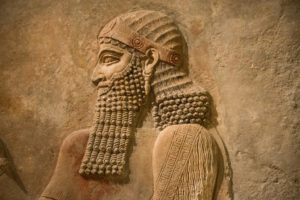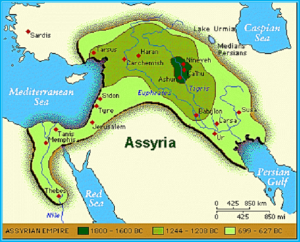Who was there among all the gods of those nations that my fathers utterly destroyed, that could deliver his people out of mine hand, that your God should be able to deliver you out of mine hand? Now therefore let not Hezekiah [King of Judah] deceive you, nor persuade you on this manner, neither yet believe him: for no god of any nation or kingdom was able to deliver his people out of mine hand, and out of the hand of my fathers: how much less shall your God deliver you out of mine hand?
deliver you out of mine hand? Now therefore let not Hezekiah [King of Judah] deceive you, nor persuade you on this manner, neither yet believe him: for no god of any nation or kingdom was able to deliver his people out of mine hand, and out of the hand of my fathers: how much less shall your God deliver you out of mine hand?
– King Sennacherib of Assyria (attr.), 2 Chronicles, 32:13-15
Bloodthirsty Assyria
While the question of the sheer wickedness of the Assyrian people as a whole is open for debate, the bastardry of their kings is not. It is pretty much agreed that these guys were ruthless, fearsome, terrifying, and bloodthirsty. Sennacherib, the king of Assyria (in the northeastern part of present-day Iraq) from 705 to 681 b.c., rates a mention in the Bible for his siege of Jerusalem and other bastardry.
Not a conqueror himself, Sennacherib spent all of his time and energy consolidating the conquests of his father, Sargon II (reigned 722-705 b.c.). He went about this vigorously and bloodily. When Hezekiah, the king of Judah (a kingdom in the southern portion of present-day Israel), refused to recognize Sennacherib’s authority, Sennacherib conquered dozens of Hezekiah’s cities and laid siege to Jerusalem.
The Bible states that Sennacherib only lifted his siege of Jerusalem after an angel of the Lord went out among the Assyrian army and killed 185,000 of them. According to Sennacherib, he only left because he had killed so many thousands of Israelites, carried off thousands of others into slavery, and stripped every city and town that fell before him. Oh, and then there was the massive indemnity that King Hezekiah of Judah agreed to pay him: about 1,800 pounds of gold and nearly 5,000 pounds of silver, not to mention “diverse treasures.”

Bastard in His Own Words
After putting down rebellions against him in Babylonia and the western provinces (Phoenicia, Philistia, and Judah), Sennacherib did what most kings do after accomplishing a great feat: he bragged about it, carving boast after boast into a stone monument known today as the “Taylor Prism.” It was the spin-doctoring of the day, and it reads in part: “Because Hezekiah, king of Judah, would not submit to my yoke, I came up against him, and by force of arms and by the might of my power I took 46 of his strong fenced cities; and of the smaller towns which were scattered about, I took and plundered a countless number . . . and Hezekiah himself I shut up in Jerusalem, his capital city, like a bird in a cage, building towers round the city to hem him in, and raising banks of earth against the gates, so as to prevent escape ….”
Final Days
Sennacherib didn’t live long after receiving this massive bribe (he was murdered in 681 b.c. by his own sons, no less). And the Assyrian Empire he worked so hard to organize and stabilize in turn did not long survive him. Assyria’s neighbors–including the Hittites, Elamites, Medes and Babylonians–eventually grew tired of the depredations of these fierce warriors. By the time they’d had enough of Assyria, these neighboring powers formed the first international war coalition in recorded history, and wiped Assyria off the map, culminating in the sack of the Assyrian capital of Nineveh, in 612 b.c.

